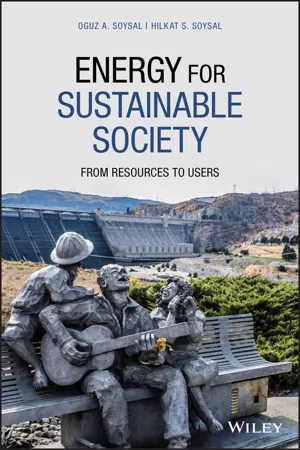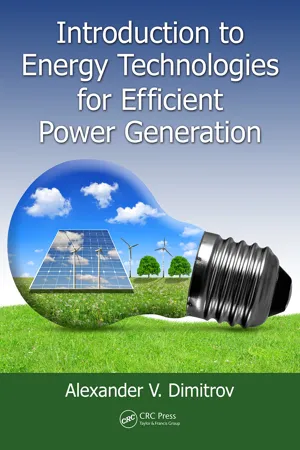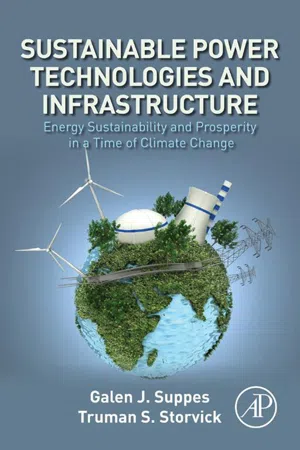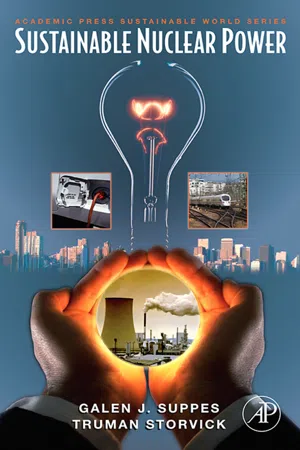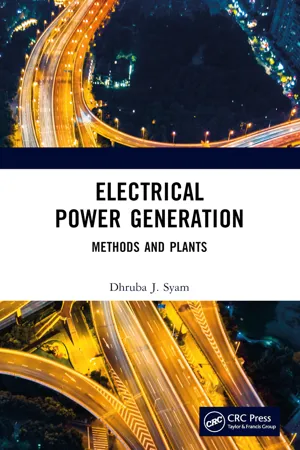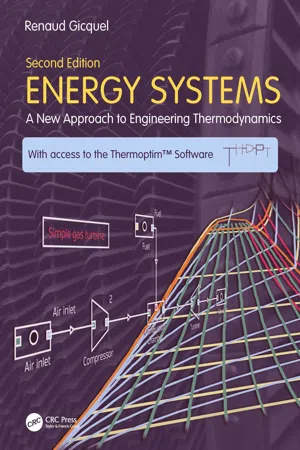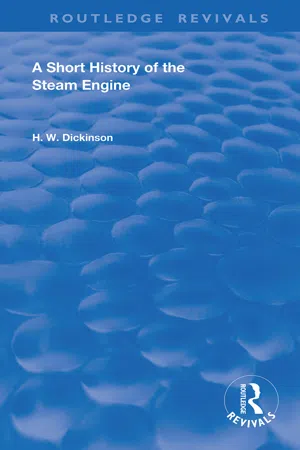Technology & Engineering
Steam Turbine
A steam turbine is a device that converts the energy from high-pressure steam into mechanical energy, which can then be used to generate electricity or propel machinery. It typically consists of a series of rotating blades mounted on a shaft, and as the steam passes over the blades, it causes the shaft to rotate, thus producing power.
Written by Perlego with AI-assistance
11 Key excerpts on "Steam Turbine"
- eBook - ePub
Energy for Sustainable Society
From Resources to Users
- Oguz A. Soysal, Hilkat S. Soysal(Authors)
- 2020(Publication Date)
- Wiley(Publisher)
Thermal power generation involves conversion of heat into mechanical work, which may be used directly or converted into electric energy. Many industrial plants produce mechanical work for their operations directly by using steam and gas turbines. Electrothermal power generation is based on converting heat into electricity using an electric generator driven by a heat engine, which converts thermal energy (heat) into useful mechanical work. All electric generation facilities using fossil fuels, biomass, waste, geothermal energy, nuclear energy, and concentrated solar energy as their primary sources convert heat into electric power using heat engines. Electrothermal power stations produce approximately 75% of the total electricity worldwide.In electric power stations, steam and gas turbines are commonly used to produce mechanical energy needed to turn the shaft of an electric generator. Whereas reciprocating engines are used in small backup generators, this Chapter will focus on turbines that are an essential element of thermal power plants. Heat engines have certain common properties; they all receive heat from a high‐temperature source, produce useful mechanical work, reject part of the heat to a low‐temperature sink, and operate on a thermodynamic cycle.In Steam Turbines, heat obtained from combustion of a fuel, nuclear reaction, geothermal fluid, or concentrated solar energy heats pressurized water in an external boiler. Saturated steam turns the turbine blades, where heat is converted into mechanical work. The steam‐water mixture leaving the turbine is cooled in a condenser. A pump or compressor circulates the cool working water back to the boiler at high pressure. The turbine converts heat into useful work, turning the shaft of an electric generator. The generator converts mechanical energy into electrical to supply the electric network through the transmission and distribution system. Figure 7.1 outlines the structure of a thermoelectric energy conversion network.Outline of an electrothermal power plant.Figure 7.1In gas turbines, the working fluid is generally hot air. Operation of gas turbines is similar to jet engines; heated atmospheric air turns the turbine blades and is discharged back into the open air where the thermodynamic cycle is completed.7.2 Principles of Thermodynamics
Thermodynamic processes are interactions between heat and mechanical work, consequently mechanical energy. Chemistry uses thermodynamic principles to explain molecular level interactions and energy exchange in chemical reactions. In physics, thermal processes are explained and analyzed using thermodynamics. - eBook - ePub
Thermal Power Plant
Design and Operation
- Dipak Sarkar(Author)
- 2015(Publication Date)
- Elsevier(Publisher)
Chapter 6Steam Turbines
The Steam Turbine handles the maximum power demand among all stationary prime movers that are used for electric power generation. A Steam Turbine is a constant volume machine. The relation between nozzle-box pressure and stage pressures vs. load is linear in nature. There are two basic types of Steam Turbines. The impulse stage is best suited for high-pressure region and for small steam quantities. The reaction stage is advantageous at the lower pressure region, where a large volume of steam must be handled. There are three basic methods of steam admission to the turbine: throttle governing, nozzle governing, and bypass governing. Lubrication of the Steam Turbine is required to minimize the rotating friction in the bearings as well as to cool the bearing surfaces. The operation of Steam Turbines suffers from various losses. The Steam Turbine is designed with three distinct operating regimes: constant pressure, true sliding pressure, and modified sliding pressure.Keywords
impulse; reaction; nozzles; moving blades; rotor; turning gear; governing; lubrication; losses; constant pressure; sliding pressure6.1 Introduction
The objective of all heat engines is to convert heat energy into mechanical work. In all heat engines some working fluid is used to which heat is applied, causing it to expand and to perform work overcoming external resistances. After completion of the expansion process heat of the working fluid is rejected to a sink. Thereafter, the fluid receives fresh supply of heat from the source.The working fluid of a steam power plant is “water.” The plant is comprised of a steam generator , in which water receives heat from the heat of combustion of fossil fuels and gets converted to high-energy steam, which then expands through a Steam Turbine and undergoes changes in pressure, temperature, and heat content. During this process of expansion the high-energy steam also performs mechanical work. The plant also consists of a condenser , where steam rejects heat in cooling water and returns to the original state (Figure 6.1 - eBook - ePub
- Michel Feidt(Author)
- 2017(Publication Date)
- ISTE Press - Elsevier(Publisher)
5.4 External combustion engines
Section 5.3 has shown that a turbine could be an ECE or an internal combustion engine, according to the configuration developed.Due to their working principle, not all engines have this ubiquity, but they are, nevertheless, very important. This will be briefly examined in the following two sections that are dedicated to two types of engines with very similar thermodynamic models.Figure 5.10 Photograph of Denis Papin’s steam engine. For a color version of this figure, see www.iste.co.uk/feidt/thermodynamics1.zip5.4.1 Renewal of steam engine?
5.4.1.1 Thermal power plants and Steam Turbine
Figure 5.11 Photograph of a steam engine. For a color version of this figure, see www.iste.co.uk/feidt/thermodynamics1.zipCentralized generation of electricity in France relies mainly on steam power plants (about 86% being of nuclear type). Figure 5.12 shows a schematic representation of the thermomechanical system of a power plant.Quite complex in reality, this system has been simplified by highlighting two main functions:Figure 5.12 Schematic representation of a thermoelectric power plant– steam generation (water is a well-known fluid, which is inert from an environmental perspective);– steam used for electricity generation.5.4.1.1.1 Steam generation
This takes place in the steam generator, which comprises what is commonly called a boiler. Industrial boilers have various and complex technological forms, depending on the primary source of heat: standard fuels (coal, fuel oil, gas or other fuels), nuclear fuels, heat discharges or solar energy.– Gas circuitsWith the exception of nuclear and solar boilers, combustion requires an air (oxidizer) circuit and an exhaust gas circuit. These circuits allow the control of heat behavior and optimal use of combustion heat, including heat recovery from flue gases. - Alexander V. Dimitrov(Author)
- 2017(Publication Date)
- CRC Press(Publisher)
2Conversion of Thermal Energy into Mechanical Work (Thermal Engines)Energy-related (power) technologies may be treated as a combination of engineering-technical methods of energy and work conversion employed to facilitate human life. They are divided into two main groups. The first group comprises technologies of heat conversion into another type of energy (mechanical, electrical, electromagnetic, etc.) while the second one comprises technologies of heat transfer, accumulation, and regeneration. Each thermal technology discussed herein will be illustrated by specific physical schemes and devices. We shall consider them in the following order:•Technologies of mechanical work performance (so called thermomechanical technologies) •Technologies of generation of electrical energy (thermoelectric technologies) •Technologies of heat transformation (regeneration and recuperation) •Technologies of heat transfer and collection (transfer and accumulation) •Technologies creating comfortable environment (air conditioning and ventilation)Thus, we will treat a certain technology as an object of study of respective scientific-applied research fields, on one hand, and we will follow the teaching programs on “Power engineering,” “Transport management” and “General mechanical engineering,” on the other hand.2.1 Evolution of Engine TechnologiesAs is known from physics, energy conversion follows a natural course, that is, energy of motion of macro- and microbodies (popular as mechanical energy) is converted into heat by mechanisms that are studied by tribology (including dry, semi-dry, viscous, or turbulent friction). No opposite transformation is observed in nature. Heat conversion into energy needed for the operation of machines and mechanisms was an impossible task for primitive people as well as for those living in slave-holding* and feudal†- eBook - ePub
Sustainable Power Technologies and Infrastructure
Energy Sustainability and Prosperity in a Time of Climate Change
- Galen J. Suppes, Truman S. Storvick(Authors)
- 2015(Publication Date)
- Academic Press(Publisher)
Additional side streams can be withdrawn as the steam pressure decreases through the turbine. The turbine drives a dynamo to produce electricity as it provides steam at the desired pressure for the process. Central heating plants for large buildings or building complexes—a university is an example—always produce electricity with the steam before it is distributed to heat rooms or buildings. Steam Turbines that deliver 50–10,000 horsepower have been designed to drive pumps and blowers and are distributed throughout chemical plants and petroleum refineries. These turbines are designed to operate with “available steam.” The steam discharged from these turbines is then used in the plant as process steam (a heat source for processing chemicals). This combination of producing work for rotating machines and providing process steam is an efficient way to use more of the thermal energy from the fuel that produced the steam. The Steam Turbine is the primary source of power to drive dynamos in electric power stations. There are many power stations with electricity as the only product. In these power plants, the steam from the turbine is condensed and the low-temperature thermal energy is discarded. The power plants that use fossil fuel and the nuclear power plants are different. Fossil fuel plants use higher pressure steam and higher temperatures, and nuclear plants are limited to lower temperature “wet” steam. Figure 4.5 illustrates the steam cycle and the key components of that cycle. The plants that use fossil fuel such as coal, oil, or natural gas generate high temperature (typically 1000°F or 538°C), high-pressure (3550 psi or higher) steam. The steam actually passes through three or four turbine stages all mounted on one shaft. As the temperature and pressure of the steam decrease, the turbine wheels get larger and the metal alloy in the turbine blades changes to match conditions of the steam and the rotational stress on the blades - eBook - ePub
- D. Yogi Goswami, Frank Kreith, D. Yogi Goswami, Frank Kreith(Authors)
- 2017(Publication Date)
- CRC Press(Publisher)
10Gas Turbines
Richard H. Bunce CONTENTS 10.1 Overview 10.2 History 10.3 Fuels and Firing 10.4 Efficiency 10.5 Gas Turbine Cycles 10.6 Cycle Configurations 10.7 Components Used in Complex Cycles 10.8 Upper Temperature Limit 10.9 Materials 10.10 Combustion 10.11 Mechanical Product Features Defining Terms10.1 Overview
Gas turbines are steady-flow power machines in which a gas (usually air) is compressed, heated, and expanded for the purpose of generating power. The term turbine is the component that delivers power from the gas as it expands; it is also called an expander . The term gas turbine refers to a complete power machine. The term gas turbine is often shortened to simply turbine, which can lead to confusion with the term for an expander.The basic thermodynamic cycle on which the gas turbine is based is known as the Brayton cycle. Gas turbines may deliver their power in the form of torque or one of several manifestations of pneumatic power, such as the thrust produced by the high-velocity jet of an aircraft propulsion gas turbine engine. Gas turbines vary in size from large, 775,000 hp utility machines, to small, 5 hp automobile and motorcycle turbochargers and microturbines. Now, 25–250 kW, recuperated gas turbines are being sold.Gas turbines are used in electric power generation, propulsion, and compressor and pump drives. The most efficient power generation systems in commercial service are gas turbine combined-cycle plants with net power-to-fuel energy efficiencies of more than 60% (lower heating value [LHV] basis). Simple-cycle plants used in electric power generation have achieved efficiencies of over 40% (LHV basis).10.2 History
The fourth quarter of the nineteenth century was one of great innovation in power machinery. Along with the spark-ignited gasoline engine, the compression-ignited diesel engine, and the Steam Turbine, engineers applied their skills to several hot-air engines. Charles Curtis received the first U.S. patent for a complete gas turbine on June 24, 1895. Jens William Aegidius Elling designed and built the first gas turbine in Norway in 1903, which produced 11 hp. - eBook - ePub
- Galen J. Suppes, Truman Storvick(Authors)
- 2006(Publication Date)
- Academic Press(Publisher)
The power output of a turbine increases as the temperature and pressure of the inlet steam increase. Higher temperatures require special metal alloys for the turbine blades and for the turbine casing that must contain the steam as it flows through the turbine. The high steam pressure and rotational speed of the turbine rotor place forces on the turbine blades that must be designed to withstand the stress without bending or breaking. The rotating blades must stay perfectly aligned so there is no contact with the stationary blades. The blades must be flexible enough to avoid brittle fracture, but they must also be designed so they do not flutter (like a window blind on an open window on a windy day) because even a small vibration could destroy the turbine.Material science and technology research funded by the U.S. military developed and demonstrated that new high-performance metals could meet the demands on Navy ships. The military turbine technology was soon available to private industry because better performance reduces the cost of operating the turbine. The firms that produced the military turbines also produced turbines for industry, and it was natural to transfer the technology from the military to the private sector.Process Steam and Its UseSteam Turbines are very versatile. They have been designed to operate with very hot, dry, high-pressure steam or with lower-temperature, low-pressure, wet steam. Large central heating plants produce steam that is used in petroleum refineries and chemical plants to heat process streams. Controlling the pressure of condensing steam controls the temperature that the thermal energy passes to the process. We get a high processing temperature when the condensing steam pressure is high and low temperature at low pressure. It is simplest to build a steam boiler that operates at constant temperature and pressure so the steam plants are usually designed to produce all of the steam required at a pressure greater than required for any process in the plant. - eBook - ePub
Electrical Power Generation
Methods and Plants
- Dhruba J. Syam(Author)
- 2023(Publication Date)
- CRC Press(Publisher)
3 Steam Turbine Driven Thermal Power Generation (STG) Plants “A complex concept requires a complex approach in visualization, but the detailing should be done in simpler manner for enabling practical configuration and implementation” — Author 3.1 Introduction The STG Plants are designed to convert Heat Energy into Mechanical Rotating Energy, to eventually get further converted to Electrical Power which, at the user’s end, provide the Electrical Energy for various usages. 3.2 A Conventional Stg Plant A conventional STG plant comprise of some major Equipment Systems and certain Auxiliary Equipment to make it work as a composite operating set up. 3.2.1 Major Equipment Comprise of Boiler: Generally water-tube type ones to generate super heated steam at the desired temperature, pressure and in required volumetric quantities (generally denoted in tonnes/hr). Steam Turbine (ST): To act as the Prime-Mover to provide the rotating mechanical force in the form of Torque to the coupled rotor of the Turbo-generator. Turbo-Generator(TG): To Generate Electrical Power when it’s rotor acting as a rotating magnet (being excited with Direct Current in it’s windings) creating a rotating magnetic field which induces Electro-Motive-Force (EMF) in the stator windings of the TG (by following the principle of Faraday’s Law of Electro-Magnetic Induction); this process in turn creates a Potential Difference (also called Voltage) between different terminals of the Stator windings from where Power is drawn for the electrical. load-networks. Besides the local distribution systems, the bulk of the generated power is evacuated through the Grid system (OH Transmission lines) to various load-centres located far and wide - eBook - ePub
- Don M. Pirro, Martin Webster, Ekkehard Daschner(Authors)
- 2017(Publication Date)
- CRC Press(Publisher)
One of the more economical ways of generating this steam is with a combined cycle plant, where high-pressure steam is used to power equipment such as generators, and the exhaust steam from this equipment is used for heating or other services. The steam is generated at high pressure and, after expansion through the turbine to the pressure desired for process use, it is delivered to the process application. This permits power to be generated by the turbine without appreciably affecting the value of the steam for process use. It may be done with a back pressure turbine designed to exhaust all the steam against the pressure required for process use, or it may be done with an automatic extraction turbine in which part of the steam is withdrawn for process use at an intermediate stage (or stages) of the turbine and the remainder of the steam exhausted to a condenser. Such a turbine requires special governors and valves to maintain constant pressure of the exhausted steam and constant turbine speed under varying turbine load and extraction demands. Steam can be also extracted without control from various stages of a turbine to heat boiler feed-water (regenerative heating). Such turbines are called uncontrolled extraction turbines, because the pressure at the extraction points varies with the load on the turbine. To obtain higher efficiency, large turbines (called reheat turbines) are arranged so that after expanding part way, the steam is withdrawn, returned to the boiler, and reheated to approximately its initial temperature. It is then returned to the turbine for expansion through the final turbine stages to exhaust pressure. High-pressure noncondensing turbines have been added to many moderate-pressure installations to increase capacity and improve efficiency - eBook - ePub
Energy Systems
A New Approach to Engineering Thermodynamics
- Renaud Gicquel(Author)
- 2021(Publication Date)
- CRC Press(Publisher)
Figure 2.31 , which was completely manufactured by a 3D printer, can withstand temperatures above 1,250°C at 13,000 revolutions per minute.FIGURE 2.31 Modern turbine blade. (Courtesy Siemens Energy.)In aeroderivative gas turbines of the most powerful last generation, cooling of the blades is no more carried out by air circulation, but by water vaporization, which can benefit from the high heat transfer coefficients in a two- phase system.The analytical and numerical models that will be presented in this book do not specifically take into account the cooling of the blades in the calculations of gas turbines.Energies brought into play in the processes
To be able to model the energy systems which interest us, it is necessary to introduce a certain number of notions of thermodynamics. Our aim is to adopt as simplified an approach as possible, and we will limit theoretical developments as much as we can. Study these concepts well, even if they seem a little vague at first. Their meaning will become increasingly clear to you as you have the opportunity to put them into practice.Notions of thermodynamic system and state
Let us begin by introducing the concept of thermodynamic system , which represents a quantity of matter isolated from what we call the surroundings by a real or fictitious boundary . This system concept is very general in physics and is found especially in mechanics.These three concepts are fundamental and will be widely used later.By way of illustration, Figure 2.32 shows that it is possible to define the boundary of the “steam power plant” system in several ways, represented by a rectangle drawn in thin lines.FIGURE 2.32 The four basic functions.The usual definition, identified by the letter A, is illustrated by the left part of the figure. The flows crossing the boundary are the hot gases coming from the hot source and the cooling fluid coming from the cold source. The mechanical power leaving the system is that which drives the electric generator. It implicitly assumes that the compression work of the pump is taken from that provided by the turbine. - eBook - ePub
- H. W . Dickinson(Author)
- 2022(Publication Date)
- Routledge(Publisher)
1 consisting of a ring of blades were fixed on a rotor within a fixed cylinder whence projected inwards rows of blades alternating with those of the rotor. Steam flowing parallel to the axis of the machine along the annulus between the rotor and the cylinder supplies the first turbine, and the exhaust from that is the supply of the second and so on, the pressure thus imparted being expended in driving the rotor blading. The pressure drop between each turbine being small, the velocity is within practical limits of shaft speed. To allow for the increase in volume of the steam as its pressure falls, the pitch and length of the blades are increased towards the exhaust end. To counteract end thrust, one right and one left set of turbines were provided and the boiler steam introduced centrally between them. Nor was this all; there were the mechanical problems involved by the high speed, amounting to thousands of revolutions as compared with the hundreds in the case of reciprocating engines. Shall we say without irreverence that the time had at long last arrived when, to use the words of Watt: “God made it possible for things to move a thousand feet per second”? These problems, the centrifugal forces, the bearings and their lubrication, the governing, were thought out and provided for. This was the construction shown in Parsons’s world-famous patent of 1884, April 23, No. 6735, for “Improvements in rotary motors actuated by elastic fluid pressure and applicable also as pumps”, a patent comparable in importance to that of Watt of 1769 for the separate condenser.1 The nomenclature of the Steam Turbine adopted in these pages is as follows: Axial, not parallel, flow; Radial, inward or outward, flow; Cylinder, not casing nor stator; Rotor, not drum, shaft nor spindle.The idea of the turbine from the beginning was that of a machine that should drive directly the newly-introduced dynamo or electric generator, which, as we have seen, demanded a speed of about 1200 r.p.m. This while enormous for the reciprocating engine was small for the turbine, the speed of which was more than ten times as great, so that Parsons, alive to this fact, had to design a new generator. For this he took out a patent at the same time as that for the turbine, viz. in 1884, April 23, No. 6734, for “Improvements in electric generators and in working them by fluid pressure”. We cannot pursue this aspect of his work further than to recall what Dr Gerald G. Stoney, his lifelong colleague and friend, says about these beginnings:1
Index pages curate the most relevant extracts from our library of academic textbooks. They’ve been created using an in-house natural language model (NLM), each adding context and meaning to key research topics.
Explore more topic indexes
Explore more topic indexes
1 of 6
Explore more topic indexes
1 of 4
